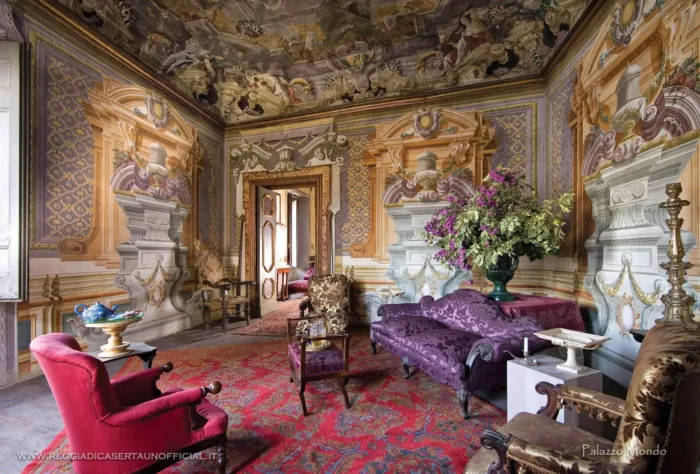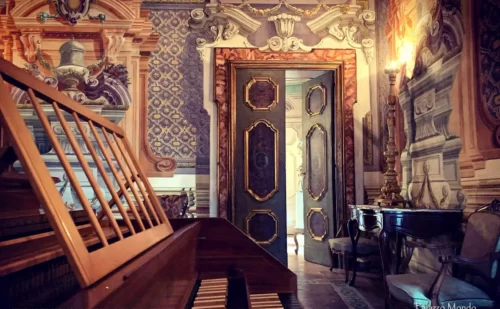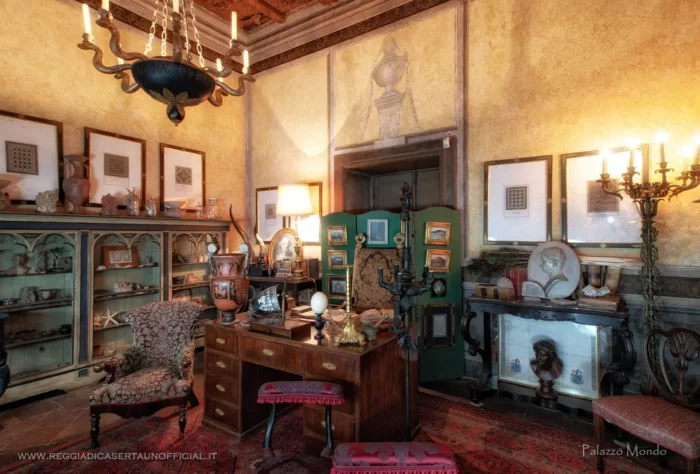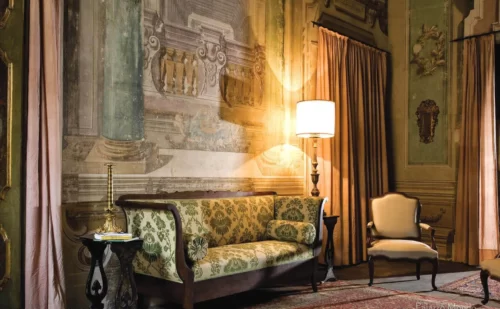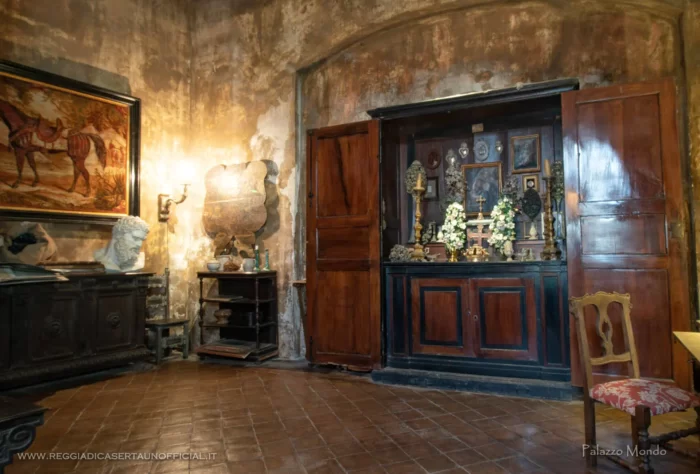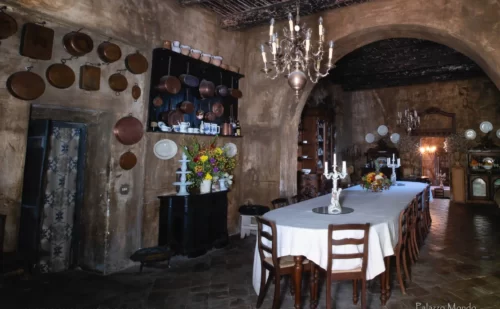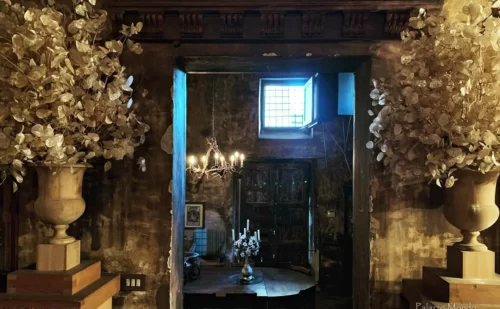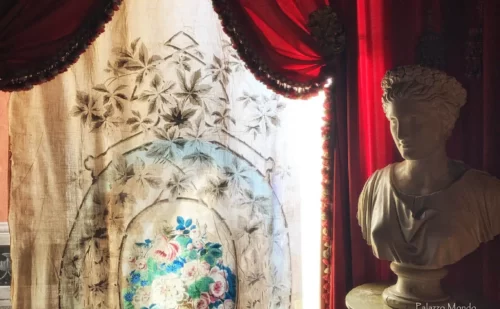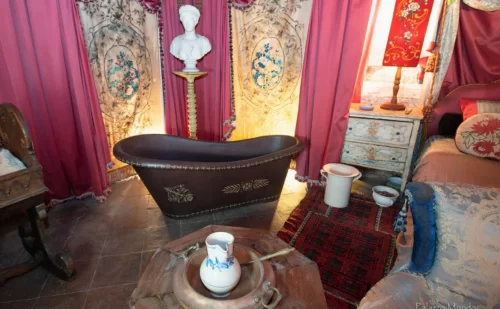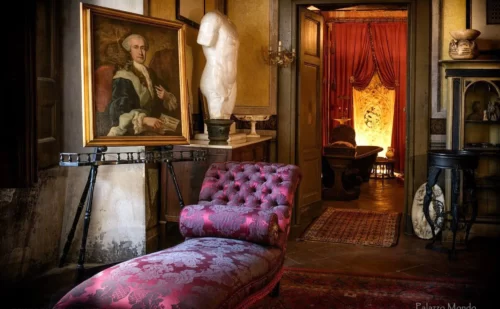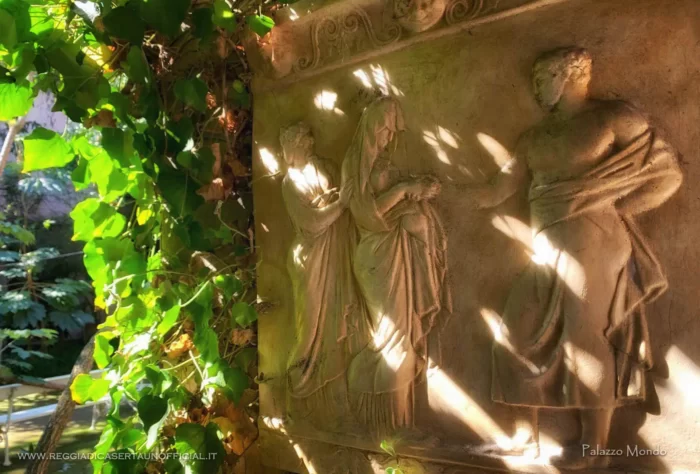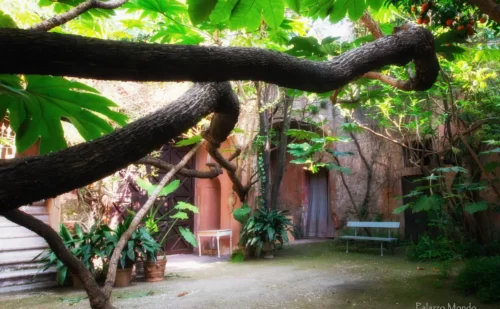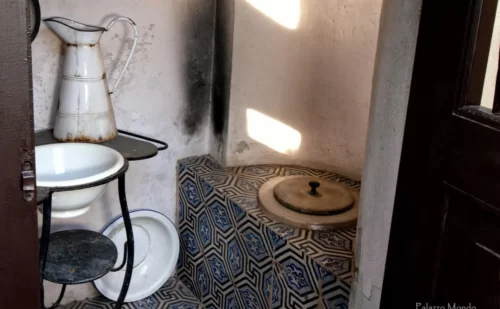Palazzo Mondo in Capodrise
Palazzo Mondo, home of the 18th century painter Domenico Mondo, is an example of aristocratic architecture of Southern Italy between the Baroque and the Neoclassical.
History of Palazzo Mondo
The Palazzo Mondo, from the second half of the century. XVIII, is an example of stylistic transition between the Rococo taste and the Neoclassical taste of archaeological inspiration and perfectly represents the aristocratic architecture of southern Italy.
The fragmentarily preserved first floor apartment is full of suggestions.
You can visit a Rococo living room frescoed on the walls and on the vault, the dining room, a room dedicated to Vanvitellian projects of the Royal Palace of Caserta, a studio painted in yellow and decorated with Etruscan borders, a bedroom with walls painted in Pompeian red and antique edges, a prayer room.
On the frescoed vault of the Rococo living room, you can admire the architectural perspectives painted by the Magri brothers, scenographers of the Bibiena school, and in the corners you can recognize the allegorical figures painted by the painter Domenico Mondo (Capodrise 1723 - Naples 1806), depicting the Cardinal Virtues ( Faith, Hope, Charity) and the Theological Virtues (Strength, Prudence, Justice, Temperance).
The painter Domenico Mondo, trained in Naples in the workshop of the famous Francesco Solimena, lived in Capodrise until 1789, the year in which he was appointed, together with the neoclassical painter Wilhelm Tischbein, director of the Royal Academy of Drawing in Naples.
A single coloristic trait and a nostalgic atmosphere outline the physiognomy of the garden courtyard, enclosed between high tuff walls and rustic rooms on the ground floor.
___________
The Palazzo Mondo, from the second half of the century. XVIII, is an example of stylistic transition
between the rococo taste and the neoclassical taste of archaeological inspiration. The fragmentarily preserved first floor apartment is full of suggestions.
You can visit a Rococo living room frescoed on the walls and on the vault, the dining room, a room dedicated to Vanvitellian projects of the Royal Palace of Caserta, a studio painted in yellow and decorated with Etruscan borders, a bedroom with walls painted in Pompeian red and antique edges, a prayer room.
On the frescoed vault of the Rococo living room, you can admire the architectural perspectives painted by the Magri brothers, scenographers of the Bibiena school, and in the corners you can recognize the allegorical figures painted by the painter Domenico Mondo (Capodrise 1723 - Naples 1806), depicting the Cardinal Virtues ( Faith, Hope, Charity) and the Theological Virtues (Strength, Prudence, Justice, Temperance).
The painter Domenico Mondo, trained in Naples in the workshop of the famous Francesco Solimena, lived in Capodrise until 1789, the year in which he was appointed, together with the neoclassical painter Wilhelm Tischbein, director of the Royal Academy of Drawing in Naples.
A single coloristic trait and a nostalgic atmosphere outline the physiognomy of the garden courtyard, enclosed between high tuff walls and rustic rooms on the ground floor.
taken from https://www.dimorestoricheitaliane.it/dimora/palazzo-mondo-capodrise/
The halls
Corner hall
The corner living room (also called "Sala delle Virtù" or "Sala Rococò") has a terracotta floor enriched by a majolica panel. The simplicity of the tiles balances the decorative sumptuousness of the ceiling and walls. These, in fact, are embellished by the late Baroque frescoes by Domenico Mondo (Capodrise 1723, Naples 1806).
The artist, a pupil of the painter and architect Francesco Solimena, inherited many interests from his father Marco. Therefore, although he preferred painting, he dealt with literature, music and poetry. His pictorial style, characterized by large volumes, iridescent colors and theatrical gestures, was much appreciated by Luigi Vanvitelli who, consequently, wanted him in the circle of artists engaged in the works of the Royal Palace of Caserta. For it, in 1785, Mondo frescoed the Hall of the Halberdiers, depicting “The Arms of the Bourbon House supported by the Virtues”. Finally, in 1789 King Ferdinand IV of Bourbon assigns him the direction of the Royal Academy of Fine Arts in Naples together with the German J.H.W. Tischbein.
The "Trompe l'oeil" of the House Museum, built between the sixties and seventies, seems to be the only work created by the painter for a private building. On the ceiling there is a central perspective, while in the corners we admire the allegories of the Theological Virtues (Faith, Hope, Charity, Justice) and the Cardinal Virtues (Fortitude, Prudence, Temperance). They are paired two by two as follows: Temperance (in the act of mixing water and wine) with Charity (nursing babies), Fortitude (wearing armor) with Hope (holding an anchor ), Prudence (equipped with a mirror) with Faith (holding a lighted candle).
The absence of Justice is evident in the fresco, replacing it with two other female figures. They symbolize the marriage commitment. The woman dressed in green on the right holds a knotted ribbon, an allegory of conjugal union, and the woman on the left holds a yoke, a metaphor for patience. The eight allegorical figures are inserted in the illusory architectures of the Magri brothers, adorned with flowers, fruits and other decorative elements.
The study
The study lounge has yellow walls and is neoclassical in style. The color recalls that used in the houses of Herculaneum. The city, buried by the eruption of Vesuvius in 79 AD, came to light in 1709 by the farmer Ambrogio Nocerino who discovered the site while digging a well to irrigate his garden.
One of the most popular themes to entertain the guests was called “Vases and Volcanoes” (Vases and Volcanoes). In fact, in the eighteenth century, eruptions and archaeological excavations were topics of considerable interest and of absolute novelty.
The room is the expression of nascent taste, inspired by classical Greco-Roman art and the aesthetic vascular system of Greek artifacts. In the Roman tombs, objects were sought that, due to their shapes and style, were part of a vascular production identified with the expression "Etruscan taste". In reality, it was not easy to find Greek amphorae from the seventh century BC, a period in which Italy was inhabited by Samnite populations and by Greeks; sometimes, in fact, artifacts were found that referred to the primitive culture of Knossos and Festus. Such objects, although more than five centuries old, were often discarded and left in tombs.
It is interesting to underline in this regard that the room houses a small collection of archaeological finds. It is made up of Greek vases, antefixes and more archaic objects, among which a valuable artefact with a totem structure and apotropaic horns stands out. In the display case there are also elements from the natural world, such as shells, stones and insects. Furthermore, on the walls, there are some engravings by artists of the eighteenth century that reproduce mosaics of Herculaneum and Pompeii.
Gallery (Anteroom)
The "Hall of the Gallery", or antechamber, which precedes the "Rococò Room" with the frescoes by Domenico Mondo, is what remains of a large representative room that was originally served by a central balcony and two side windows. The walls of the room are embellished with frescoes by the brothers Giuseppe and Gaetano Magri, quadraturist painters of the Bourbon court. In this regard, it seems only right to remember that Gaetano Magri worked on the decoration of the Court Theater of the Royal Palace of Caserta and also painted the frescoes in the Villa of Cardinal Spinelli in Torre del Greco.
The "Trompe l'oeil" of the house-museum simulates a long gallery that opens towards the observer and gives the perception of a space delimited by a series of green columns on high plinths. In the nineteenth century, following the splitting of the building, the large hall was separated in two by a dividing wall, in the center of which is now the period fireplace that once stood at the back of the room. Upon careful observation, it is clear that the frescoes in the antechamber of the house-museum once continued beyond the mirrored partition wall. Proceeding from the dining room, one immediately catches the eye a pantry containing a delicious set of eighteenth-century porcelain cups and saucers.
Hall of Trophies
The "Trophy Room", which can be accessed from via Francesco Rao, is rich in furnishings and suggestions. Once used as a service area, it is named for the trophies with deer and elk antlers that adorn the walls. They are the direct testimony of the customs and habits of a local nobility who loved to exhibit and practice hunting activities. In the center an oval table dominates but, looking to the right, we notice an interesting transforming piece of furniture. It is a wardrobe with a pull-out drawer which, once opened, becomes an altar. Thanks to it, the priest could celebrate mass in private environments.
The piece of furniture is also equipped with a support surface on which floral compositions, candles and other objects are placed and on the bottom of the same we appreciate some paintings attributed to the Solimena School and old sacred furnishings.
Dining room
The large dining room on the main floor is characterized by furnishings and elements that testify to the neoclassical interest in archeology. There are, in fact, engravings and replicas of the artifacts found in Pompeii and Herculaneum. These objects were real souvenirs of the Grand Tour. It was a long and tiring journey undertaken by the young aristocrats to complete their education. The young offspring moved on horseback and lodged with the great noble families, bravely going as far as Naples. The latter, close to Africa, was considered a very dangerous city. The young aristocrats wrote notes, reproduced ancient objects, paintings and architecture. They were, therefore, the true spreaders of the renewed interest in Greco-Roman art. In the nineteenth century, with the emergence of the bourgeoisie, a social class made up of merchants and entrepreneurs, the mentality and way of traveling changed. The Grand Tour ends in the early twentieth century to make room for the advent of mass tourism.
In this room we can admire two large eighteenth-century canvases made with the oil technique (150X252 cm). The two works are entitled "Gallant scene in a garden with flute player" and "Gallant scene in a garden with mandolone and tambourine players". They depict concert scenes between flowers, fruits and pottery and are linked to the genre painting and still life trend. The latter reached its peak in the seventeenth century following the pictorial innovations introduced by Caravaggio, but in the second half of the eighteenth century, with the advent of the Enlightenment and the new style, it gradually lost importance. Among the various objects, we also note a sedan chair that was used by the nobles of the time to move around in total privacy. It was also used inside very large rooms, such as the Royal Palace of Caserta and the Vatican in Rome.
Dining room on the ground floor
The dining room on the ground floor, an obligatory passage for those entering the courtyard coming from the trophy room, is very large and contains a long table. This room is used as the seat of the institutional meetings of the Gia.D.A. (Gardens and Dwellings of Harmony) and the Association of Italian Historic Houses (ADSI). For some years it also hosted the members of the FAI foundation (fund for the Italian environment).
Bedroom
The bedroom, present on the second floor, includes neoclassical furnishings even if there are mixes with the baroque style represented by the baroque canopy but the realization of the soft drapery is neoclassical. There are elements that anticipate the movement following the Baroque or the Neo-Gothic and these elements are the cradle, particular in the sound as it was made so that children, hearing this sound similar to the heart of a mother, easily fall asleep. To avoid being seen from the outside, painted silk curtains were used so as not to show anything, so it is very clear of the sense of modesty that existed in the building and the idea of looking consisted of landscapes and not the countryside. There is a painting from the time of Domenico Mondo, attributed either to the latter or to Paolo Di Maio in Baroque style, depicting the infusion of wisdom to a saint by an angel from a baroque sky. In addition to this painting, there are other eighteenth-century school paintings whose identity is unknown and they are donations and are thought to be people known by Domenico Mondo because the era and the clothing recall his era. The figures in the picture are women, some dressed according to the Baroque style with white wigs that characterized that era, while others have clothing belonging to the era of archaeological classicism which provided that women wore their hair loose, smooth and without use. of white talc and fake talc and their clothing was at the bear, that is, they dressed like the Greek statues. On the outside, the windows are decorated with triangular and lunette trabeations, reminiscent of period architecture.
Prayer room
The small but enchanting "room of prayer" houses the wooden statue of the Pilgrim Madonna. It was called this way because it was carried around to raise funds for the restoration of the Capodrise church. The statue is a self-propelled automaton and was a gift of the Marchesa Luisa Cocozza di Montanara, owner of the Cocozza Palace in Piedimonte di Casolla. The statue which resembles the Queen of Naples in features, hair and color of the complexion, represents, in a sort of symmetry between heaven and earth, the clear correspondence between Maria Carolina of Habsburg Lorraine, queen on earth, with Our Lady, Queen of Heaven. It must be remembered that she is wearing a red silk brocade dress with gold and silver floral patterns donated by the Sovereign of Naples herself. Inside the room, right in front of the statue, there is a dark red quick-change piece of furniture which, if necessary, can be transformed from an armchair to a kneeler.
The garden
The picturesque courtyard-garden, designed by the architect Nicola Tartaglione, is characterized by the perfect mix of natural and artificial forms. The long and twisted stems of the papyriferous aralias extend to embrace all the architectural elements, from the well to the arches. The result is vibrant and restores the perception of a kingdom in which order becomes an accomplice of chance. The colors of the outdoor furnishings recall the colors of the blooms of the datura, the agapanthus and the aralias. The courtyard-garden houses an old wood-burning oven and offers access to the ancient stables. Walking through the green space we discover two Roman pots and other archaeological finds found in the surrounding countryside which, like the house-museum, are subject to the historical-artistic constraint. The jars are vases from the 2nd century BC. C. useful for the conservation of oil and grain that were placed below the ground level so that the foodstuffs received stable and constant humidity ratios.
On the side of the courtyard that runs along Via Domenico Mondo there is a staircase built in the mid-nineteenth century. It represents the only access to the first floor and is characterized by the presence of two marble busts. The main floor is introduced by a loggia with large arches and is served by an eighteenth-century bathroom. The latter, conceived as a trough and used by the lords through the servants, is covered with majolica decorated with geometric patterns.
The artist Domenico Mondo
Domenico Mondo (1723-1806) was born in Capodrise, near Caserta. From an early age he was directed to painting and, through contacts with painters from the circle of Francesco Solimena, the world was formed precisely in the latter's prolific workshop.
The years in which M. frequented the workshop of Solimena are those of the master's return to the great tradition of Neapolitan Baroque painting, after a long period of approaching Roman classicism. The "tenebrism" and the heavily stained painting of this extreme phase of Solimena's production characterize the first tests of the World. The altarpiece with S. Marco and the Faith in the church of S. Andrea in Capodrise dates back to 1747, the year of the master's death; for the same building, his parish church, M. made three other altarpieces in the following years.
The Assumption of the Virgin in S. Maria Assunta in Recale, still in the Caserta area, can be dated to the beginning of the sixth decade.
What is most attractive of M. are his pen studies, whose extremely pictorial effect declares a strong vocation for the purely inventive moment, that is, for that phase of the creative process in which the artist seems to have been most interested. It is likely that he conceived at least part of his drawings as works for their own sake and not as mere preliminary studies of a painting. The originality and elegance of M.'s graphic style make him, rightly, "the most brilliant of the Neapolitan Solimenesque"
With the death of his father, in 1761, a period of economic difficulties began for M. which accompanied him until his death. At least in part, these had to be the consequence of not too careful choices.
At the beginning of the eighth decade, M. finally obtained some important official recognitions: in 1771 he entered the Royal Academy of Design; the following year Vanvitelli called him to work in the Royal Palace of Caserta. Our Francesco Mondo also signed the contract relating to the execution of a series of canvases destined for the church of the Annunziata in Marcianise, he frescoed the Triumph of Bourbon weapons supported by the Virtues on the vault of the Hall of the Alabardieri in the Caserta palace, a rather cumbersome composition whose elaboration is documented by various graphic studies and by a sketch, today, in the Louvre in Paris.
Taken from https://informareonline.com/domenico-mondo-artista-barocco-origini-casertane
His fresco in the Hall of the Halberdiers in the Royal Palace of Caserta
